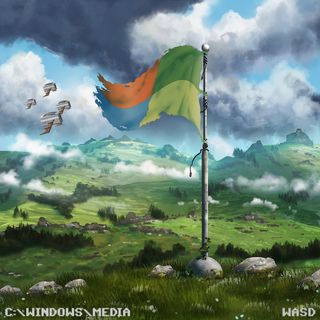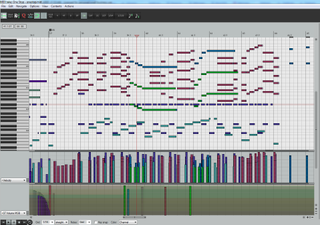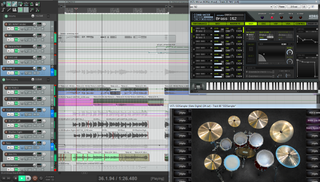Hear classic Windows midis reborn as amazing rock songs
You won't know you needed rock covers of classic midis in your life until you hear Austin Green's album. But you did.

I once burned a CD of my favorite theme songs from games and movies: Jurassic Park, Beverly Hills Cop, The Legend of Zelda, The Pink Panther. These were the kinds of melodies that get in your head and stick even without a nuanced orchestral performance—or so I like to think, because I was apparently too young or clueless to realize the versions of the songs I put on that disc were all midis. There's a purity to midi's synthesized sounds that works perfectly with a great melody, which is probably why a few songs from deep within the bowels of Windows 3.1 are still buried deep in the subconscious of some PC gamers.
Some people will be humming Jurassic Park for the rest of their lives. Others will be humming Canyon.mid.
I heard Canyon.mid for the first time in roughly two decades back in January, when we discovered an album on Bandcamp titled C:\Windows\Media. It's a collection of rock covers of the midi files that shipped with Windows 3.1, 98 and XP, played with electric guitar I can only describe as dangerously peppy. If those midis I burned to a disc were themes distilled down to their essential melodies, Austin Green's real instrumental covers of 25-year-old midis are melodies that decided to let their hair down and rock the fuck out.
"I've been remixing songs for a decent amount of time, and just doing computer game stuff was scratching the surface," Green said when we talked over Skype. "I realized people had a bit of nostalgia for other parts of computer history. And I had stumbled upon a bunch of these back on my Windows XP computer, so I knew that they existed and were kind of a hidden gem of computing that people nowadays don't really know about. There's an old video of a band playing at MAGFest a couple years ago, called The Smash Brothers, when they played Canyon.mid live. That made me realize those songs would sound really good in the style that I have."
You may have heard Canyon.mid before without realizing it, even if you never went poking around in the Windows\Media folder Green's album took its name from. The song would play in the PC version of Chip's Challenge, which would scan the Media folder on your hard drive and add midis to the soundtrack.
Green is a MAGfest regular and has released several cover albums of game songs with other musicians, under the band names WASD and Steel Samurai. His style on those projects is firmly in metal territory, with heavier drum beats, more fuzz and a whole lot more shredding. The first WASD album, Shift, includes covers of Monkey Island, Diablo, C&C Red Alert, and X-COM songs.
C:\Windows\Media, by comparison, is what he says the game music community would call a "straight cover." He added less of his own flavor, instead trying to replicate the sound of the original songs with live instruments. "I do a lot of downtuned rhythm guitar parts for a lot of the songs like Passport, and especially Canyon," he says. "I think Canyon turned out really well as just an instrumental rock song. It's perfect. It evokes that kind of '70s and '80s prog feel, which is probably what the composer was really into when he wrote it."
The biggest gaming news, reviews and hardware deals
Keep up to date with the most important stories and the best deals, as picked by the PC Gamer team.
Green was inspired to record the songs when he watched the Smash Brothers performance of Canyon.mid. He's a fan of keyboardist Jake Kaufman, aka Virt, who has composed a number of game soundtracks including Shovel Knight. But he also took an archaeological interest in the songs. At only 22, he doesn't have nostalgia for these midis from the Windows 3.1 days. But like me, he fell down the rabbit hole of investigating who originally wrote them, and why they ended up shipping with Windows in the first place.
No one seems to know who composed Passport.mid. That little bit of history seems completely lost.
The common wisdom is that these songs were included with Windows to troubleshoot midi playback, though Microsoft could've accomplished that without commissioning original songs. Canyon.mid, officially titled "Trip Through the Grand Canyon," was composed by George Stone of the company Passport Designs, an '80s and '90s music software company. But no one, including Stone, seems to know who composed Passport.mid. That little bit of history seems completely lost.
"You can find the company that made them but they never say why they were written or what got Microsoft to put these into their operating system," Green said. "When I was finishing up the album I was curious as to who owned the rights to [these songs], which is another thing that you totally can't find. I'm pretty sure Passport Designs, the company that wrote a couple of those, doesn't exist anymore. Does Microsoft own the rights to it? It's a weird piece of history."

Even weirder is Future Retro, the last song Green covered for the album. It wasn't just a midi like the rest, but a midi with a complementary early 3D CG music video by Animusic that came with Windows XP. It was the only song on the album Green strayed away from covering straight. True to the title, Green added "lots of crazy guitar parts" and a new section to Future Retro, cutting out some of the song's repetition which he said was focused on the animation. "I kind of took what was already there, changed it a little bit, and wrote something new out of it," he said.
C:\Windows\Media was about 7 months of off-and-on work for Green, who's taught himself how to arrange songs and play a number of instruments over the past several years. His gateway into music was playing bass in the 6th grade, and sneaking downstairs at night to play Metallica tabs—very poorly, he said—on his grandfather's old guitar. For this album, he imported the midi files into his audio production software Reaper, which gave him the notes and which instruments were being played in the songs. Arranging involved picking the instrumentation apart and choosing which to include in his covers, and where to change things up.
"In some cases we have to drop certain instruments or certain parts of the instruments so it doesn't get too cluttered. Too much going on, people get confused and lost," he said.


Midis are far more complex than you might expect. The original Town.mid, for example, consists of 11 tracks. "We've got steel guitar, muted guitar, bass, accordion, fiddle, trumpet, brass, alto saxophone, slap bass, and then the drums. It looks like at the most there are six parts playing at once. And then there are other elements of it. The trumpet and brass only come in at certain parts. There can be a lot of things going on that are really all over the place, but they sound really good in midi."
Green suggested all these parts can work together so well because of midi's inherent limitations. Technically, midi isn't a form of sound recording, but rather a set of instructions to a device like a PC or synthesizer on how to make sounds. Midi has to work on any piece of hardware that supports it, from the PC speaker that once beeped when you turned on your computer, to the lush soundscape of a dedicated sound card. Instruments don't sound as natural in midi, but anything will be able to play the melody.
To use as many live instruments as possible, Green played a melodica and banjo in addition to guitar and bass on the album. "The original part was a sitar, and I did not have access to that," he laughed. "I decided if I put a lot of reverb on a banjo, maybe it'll sound like a sitar."
Green wrapped and uploaded the album just before MAGFest 2017 in January. As he started working on it more heavily in the fall, he became more interested in midi in general. He bought a Roland Sound Canvas SC-55 just to listen to midi songs piped through hardware that could really do them justice. Then he started playing classic DOS games with the Roland hooked up to his speakers, to hear Monkey Island and Sam & Max and XCOM: UFO Defense as they sounded on great hardware. Green pointed me to this Lazy Game Reviews video that depicts how The Secret of Monkey Island sounds across a range of sound devices. The difference really is amazing.

Green plays at MAGFest. Photo by Max Noel.
"They have a fuller sound, and they actually take advantage of the reverb a lot better," he said of devices like the Roland. "Especially for Monkey Island, they want you to feel like you're deep in the jungle on Monkey Island, so they have a lot of huge sounds, big spaces. The normal Windows midi doesn't really interpret it the right way. I don't know if it's something with the way it interprets the special commands for the effects, but I don't think it does it as nicely as a dedicated piece of hardware."
Green started collecting random midi files. Some are from games he knows, like Final Fantasy, Duke Nukem, and Doom. Others have vague names like "camp.mid" from sources unknown. After releasing this album, Green said he plans to take a step back from recording this year to practice guitar and become a better musician. But when I asked what other midi songs he might want to cover, one came to mind.
"You know what soundtrack sounds really good?" he asked. "Warcraft 2 sounds so good. I definitely want to do some Warcraft 2 stuff."

Wes has been covering games and hardware for more than 10 years, first at tech sites like The Wirecutter and Tested before joining the PC Gamer team in 2014. Wes plays a little bit of everything, but he'll always jump at the chance to cover emulation and Japanese games.
When he's not obsessively optimizing and re-optimizing a tangle of conveyor belts in Satisfactory (it's really becoming a problem), he's probably playing a 20-year-old Final Fantasy or some opaque ASCII roguelike. With a focus on writing and editing features, he seeks out personal stories and in-depth histories from the corners of PC gaming and its niche communities. 50% pizza by volume (deep dish, to be specific).
Most Popular

